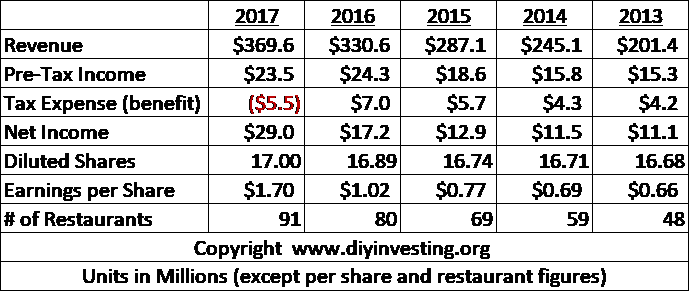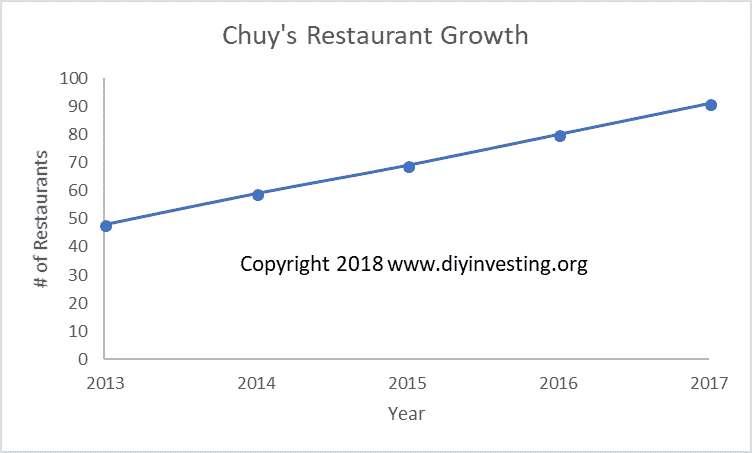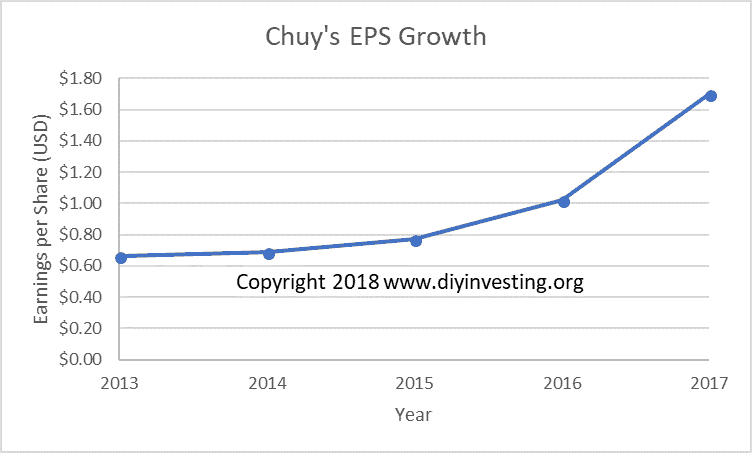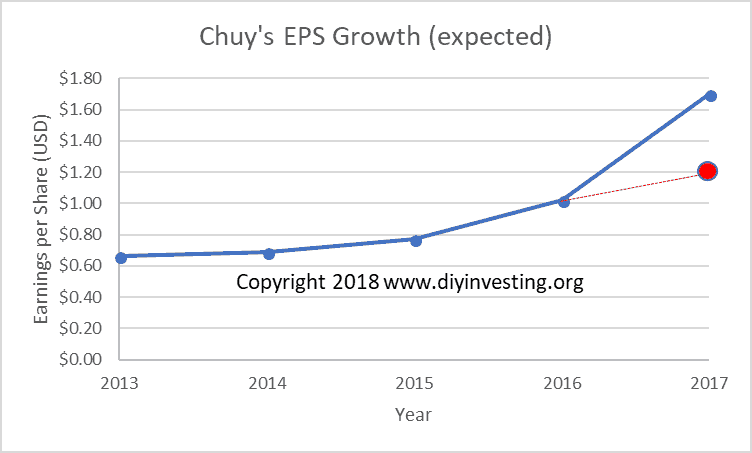I was reviewing Chuy’s 2017 annual report today in order to understand Chuy’s stock performance over the last twelve months. In early August of 2017, Chuy’s stock was trading at approximately $20 per share. Yesterday, Chuy’s stock price peaked above $34 per share. This represents a gain of 70% in less than 12 months. I read the Chuy’s annual report to see if Chuy’s business performance truly reflected a 70% improvement. It became clear that this was not the case, primarily because of the Tax Cuts and Jobs Act of 2017.
Second order effects of the Tax Cuts and Jobs Act of 2017
It shouldn’t need to be said, but this article is published on the internet, so who knows. Although I am discussing the effects of the Tax Cuts and Jobs Act of 2017, I am not in any way expressing a political opinion in favor of or in opposition to this congressional act. For the purpose of this article, I am purely focused on the second order effect on investments that this act has caused in 2018.
First order effect of the Tax Cuts and Jobs Act of 2017: Lower Corporate Taxes
The primary goal of the tax reform bill passed last year was to reduce corporate taxes. This was accomplished by lowering the federal statutory corporate income tax rate from 35% to 21%.
The result is fairly straightforward. The first order effect is that corporations will pay lower income taxes beginning in the year 2018. Therefore, companies will be able to retain a greater portion of their earnings each year going forward. As earnings are the property of shareholders, basically shareholders become richer, all else equal.
This logical analysis has led to the upward revaluation of nearly all stocks domestic to the United States. However, there is a less positive side to the Tax Cuts and Jobs Act for investors.
Second order effect of the Tax Cuts and Jobs Act of 2017: Fake Earnings for Full Year 2017
The change in the corporate tax rate has caused all businesses to revalue their deferred tax liabilities. This revaluation of their balance sheet has caused many businesses to report what are basically “fake earnings.” While businesses are legitimately reporting their earnings according to GAAP accounting standards, these reported earnings do not reflect the underlying earnings power of the business.
Granted, GAAP accounting is not meant to report earnings power in a clear and straightforward manner. Accounting is not designed to cater to investors at all. Instead, investors must learn to interpret the data and make sound judgments.
This is of even greater importance when analyzing the 2017 earnings reports of your average business.
Business Example: Chuy’s Holdings Inc (CHUY)
The clearest way to help you understand the way business results have been manipulated by the Tax Cuts and Jobs Act of 2017 is to show you an example.
Let’s take a quick look at business results for Chuy’s Holdings Inc. The below data comes from the 10K report that Chuy’s filed with the SEC. You can find the source data on Edgar.

Chuys’ earnings per share inflated by one-time tax items in 2017
It is difficult to overstate the importance of the Tax Cuts and Jobs Act of 2017 on the stock performance of Chuy’s in 2018. Chuy’s is reporting an $11.8 million difference in net income between 2017 and 2016 due to one-time tax items. In contrast, Chuy’s only had a difference of less than $1 million in pre-tax income between the two years.
Chuy’s should have expected to pay nearly $7 million in taxes in 2017. Instead, they received a tax benefit of over $5 million.
While this may seem harmless on the surface, I want to highlight the effect on reported earnings per share. In 2017, Chuy’s reported EPS of $1.70. This represents a gain of 66% over their 2016 earnings per share of $1.02.
Chuy’s business performance does not reflect it’s changing EPS
Although Chuy’s has increased its earnings per share by 66% in one year, the actual earnings power of Chuy’s has not increased as much. Chuys’ earnings power is derived primarily from the number and quality of restaurants that it operates.
In 2017, Chuy’s opened 11 additional restaurants. Eleven new restaurants are equivalent to 13.7% organic growth. While very respectable business performance, 13% growth is much lower than the 66% growth shown by reported earnings per share.
I’ve highlighted this difference in the following two charts. Below you’ll find both Chuy’s restaurant growth and earnings per share growth over the past five years.


Notice how both grow at a fairly linear rate for the first four years. However, the final year of earnings per share growth appears to be exponential in nature. The result is a misalignment between reported earnings per share and true earnings power.
Chuy’s stock performance does not reflect business performance
At the beginning of this article, I outlined how Chuy’s stock is up nearly 70% over the last 12 months. Yet, Chuy’s business performance has only improved by about 13% over the last 12 months.
How can we make sense of both of these realities?
My assertion: Chuy’s stock price reflects a misunderstanding of Chuy’s true earnings power. It is likely that many investors in the market have taken Chuy’s reported earnings of $1.70 per share at face value. If Chuy’s is valued accordingly, then a 70% increase in stock price is warranted. A 70% increase in stock price compares quite well to a 66% increase in reported earnings per share.
However, as I demonstrated in the previous section, reported earnings do not demonstrate Chuy’s true earnings power. This error is another real-life example of the failings of the efficient market hypothesis.
Estimating Chuy’s true earnings power
In order to estimate Chuy’s earnings power, I’ll use two methods. First, let’s do a very simple chart extrapolation for the earnings growth of the company. The below chart extrapolates the pre-2017 growth rate of Chuy’s earnings.

As you can see, if we simply extrapolate the growth on the chart, earnings would be much lower. However, this estimation method is quite crude. It’s much better to estimate earnings power from new restaurant openings. Restaurants are the direct avenue by which Chuy’s earns their money.
In 2016, Chuy’s operated 80 restaurants and earned $1.02 per share. Therefore, Chuy’s earned $0.01275 per share per restaurant.
By the end of 2017, Chuy’s was operating a total of 91 restaurants. Let us make the simplifying assumption that each restaurant in 2017 is just as profitable as in 2016. Using this assumption, Chuy’s earnings power in 2017 would be $1.16 per share. Our new estimate is more conservative than our chart estimate of $1.20 per share. However, it’s also much lower than reported earnings of $1.70 per share.
US Companies have distorted reported earnings for 2017
Don’t trust reported 2017 earnings for any company that operates primarily in the United States. As you can see from our Chuy’s example, the Tax Cuts and Jobs Act of 2017 has massively distorted reported earnings.
I expect that 2017 will forever be a great example of how GAAP accounting does not reflect economic reality.
Even more importantly, I hope that you take this as a lesson to always do your own due diligence before making an investment. Stock traders who only look at P/E ratio’s displayed by Yahoo or Google Finance are making a mistake of ignorance. Chuy’s appears to be trading at a P/E ratio of approximately 20 with their current stock price of $34 per share. Yet, this number is a facade. A more accurate P/E ratio for Chuy’s is much closer to 30.
